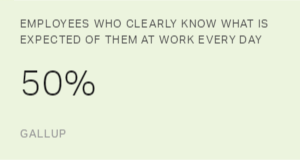Story Highlights
- Find the stories behind the numbers
- Engage and empower each department to create their own plans of action
- Play to the strengths of individuals and teams
On July 30, Sheikh Mohammed bin Rashid Al Maktoum, Vice President and Prime Minister of the United Arab Emirates and Ruler of Dubai, tweeted about employee satisfaction reports from 40 government bodies. He noted that while satisfaction was as high as 93% in some agencies, in five, it was about 60% -- considering the latter figure "unacceptable" and setting a six-month timeline for change.
Sheikh Mohammed's mandate for improved workplace satisfaction in the country's government is important for the employees themselves -- but also to all UAE citizens, who will be better served by public-sector employees who are happy with their jobs.
Through our work in advising leading organizations and our global analytics, Gallup is keenly aware of and familiar with the strategies government leaders need to successfully help employees become more engaged in their work. Gallup defines an engaged employee as someone who is highly involved in and enthusiastic about their work and workplace.
Here, are six steps leaders can take to improve engagement among their employees in just six months:
1. Set up a cross-functional steering committee. If employees view efforts to improve the workplace as "HR-only" initiatives, these efforts are unlikely to produce sustainable results. In our experience, such efforts drive long-term change only with the involvement of high-performing leaders from throughout the organization who have a significant interest in improving its culture.
A cross-department, cross-level steering committee is ideal for this purpose. The steering committee should determine common goals through discussion, set up time-bound interim objectives and establish clear accountability for each member of the team.
2. Conduct a qualitative "deep-dive" analysis to uncover the stories behind the numbers. Instead of department leaders assuming they understand the factors affecting employee satisfaction or engagement scores, the best practice is to go beyond the numbers to find out.
Identify groups within the organization that have particularly low or high engagement, and find out why through in-depth interviews, focus groups or other types of qualitative analysis. The objective here is to gain a deeper understanding of what is working well or not working well. The resulting stories should be among the inputs that the steering committee uses to develop strategies for improvement.
3. Engage each department in creating a local action plan. Efforts to drive change are implemented at the local level, among individual teams or departments. Therefore, in addition to the broad strategy crafted by the steering committee, each department should create its own action plan.
At both levels, planners should prioritize a small number of actions rather than trying to improve everything at once. A good practice is to target two areas for improvement per quarter at the entity level, then ask department heads to use one of those two for action planning and choose another one that more specifically addresses local-level concerns.
In both cases, the action should be SMART (Specific, Measurable, Attainable, Realistic and Time Bound), and the steering committee should have responsibility for tracking progress.
4. Use information about the strengths of teams and individuals. Such insights are invaluable in driving local-level conversations about how to improve team members' engagement and happiness.
Department heads who understand each employee's strengths and ways of thinking can more effectively position them for success and fulfillment in their role. Simple toolkits are available to help local-level managers implement strengths-based action plans. Such toolkits ideally include strengths assessments (such as the CliftonStrengths), conversation guides, action-planning frameworks and SMART-action templates.
5. Maintain accountability through the steering committee. The steering committee should review each department's action plans and enlist expert help in providing local managers with feedback for improvement. The quality of those action plans will play a major part in determining the success of the initiative overall.
By using SMART templates, leaders can provide objective and constructive feedback to each department, ensuring they meet the criteria needed to be effective.
6. Recognize those who follow the process very well. Recognition programs are one of the most effective and underused tools for reinforcing positive attitudes and behaviors. There needs to be a structured process to recognize departments that show the greatest improvements in engagement and happiness, and the same is true for all departments that followed their action plans diligently and made significant efforts to improve.
Importantly, recognition programs should include not only financial rewards but also non-financial aspects such as public acknowledgment of employees' accomplishments. The magnitude of these rewards should be proportional to the importance of the change initiative in your organization.
Sheikh Mohammed's call to improve government workplaces in the UAE reflects the challenge many countries face in making public agencies vibrant and enjoyable places to work. It's not an easy issue to address -- but by no means is it prohibitively difficult, either.
The UAE is off to a good start with clear recognition of the need for change at the highest levels of government. Such leadership will be invaluable in the country's efforts to design and implement comprehensive and sustainable change.
Gallup can help you create a culture that empowers your organization to be at its best and that inspires your employees to say, "I belong here."
- Build a culture that gets the best from your people through our comprehensive culture solutions.
- Bring our Leading High-Performance Teams course to your organization to help all managers understand how to build an engaging environment.
- Empower employees and teams to discover and develop their strengths using our CliftonStrengths assessment.
- Download the State of the Global Workplace report to learn why global workplace productivity is low and what leaders can do to improve it.
Steve Crabtree contributed to this article.


